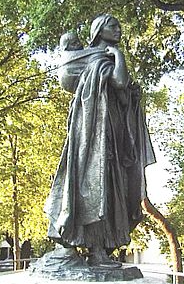"An 1811 journal entry made by Henry Brackenridge, a fur dealer at Fort Manuel Lisa Trading Post on the Missouri River, stated that both Sacagawea and Charbonneau were living at the fort. He recorded that Sacagawea "…had become sickly and longed to revisit her native country." The following year, John Luttig, a clerk at Fort Manuel Lisa recorded in his journal on December 20, 1812, that "…the wife of Charbonneau, a Snake Squaw [the common term used to denote Shoshone Indians], died of putrid fever." He went on to say that she was "aged about 25 years. She left a fine infant girl". Documents held by Clark show that her son Baptiste had already been entrusted by Charbonneau into Clark's care for a boarding school education, at Clark's insistence (Jackson, 1962)."
A few months later, fifteen men were killed in an Indian attack on Fort Lisa, then located at the mouth of the Bighorn River. John Luttig and Sacagawea's young daughter were among the survivors. Toussaint Charbonneau was mistakenly thought to have been killed at this time, but he apparently lived to at least eighty. He had signed over formal custody of his son to Clark in 1813.
As further proof that Sacagawea died in 1812, Butterfield writes: "An adoption document made in the Orphans Court Records in St. Louis, Missouri states, 'On August 11, 1813, William Clark became the guardian of 'Tousant Charbonneau, a boy about ten years, and( Lizette Charbonneau), a girl about one year old.' For a Missouri State Court at the time, to designate a child as orphaned and to allow an adoption, both parents had to be confirmed dead in court papers."
The last recorded document citing Sacagawea's existence appears in William Clark's original notes written between 1825–1826. He lists the names of each of the expedition members and their last known whereabouts. For Sacagawea he writes: "Se car ja we au- Dead." (Jackson, 1962)."
"An 1811 journal entry made by Henry Brackenridge, a fur dealer at Fort Manuel Lisa Trading Post on the Missouri River, stated that both Sacagawea and Charbonneau were living at the fort. He recorded that Sacagawea "…had become sickly and longed to revisit her native country." The following year, John Luttig, a clerk at Fort Manuel Lisa recorded in his journal on December 20, 1812, that "…the wife of Charbonneau, a Snake Squaw [the common term used to denote Shoshone Indians], died of putrid fever." He went on to say that she was "aged about 25 years. She left a fine infant girl". Documents held by Clark show that her son Baptiste had already been entrusted by Charbonneau into Clark's care for a boarding school education, at Clark's insistence (Jackson, 1962)."
A few months later, fifteen men were killed in an Indian attack on Fort Lisa, then located at the mouth of the Bighorn River. John Luttig and Sacagawea's young daughter were among the survivors. Toussaint Charbonneau was mistakenly thought to have been killed at this time, but he apparently lived to at least eighty. He had signed over formal custody of his son to Clark in 1813.
As further proof that Sacagawea died in 1812, Butterfield writes: "An adoption document made in the Orphans Court Records in St. Louis, Missouri states, 'On August 11, 1813, William Clark became the guardian of 'Tousant Charbonneau, a boy about ten years, and( Lizette Charbonneau), a girl about one year old.' For a Missouri State Court at the time, to designate a child as orphaned and to allow an adoption, both parents had to be confirmed dead in court papers."
The last recorded document citing Sacagawea's existence appears in William Clark's original notes written between 1825–1826. He lists the names of each of the expedition members and their last known whereabouts. For Sacagawea he writes: "Se car ja we au- Dead." (Jackson, 1962)."








